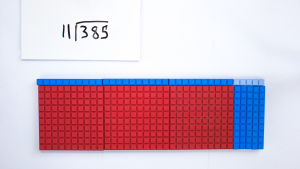
If you are a long-time user of Math-U-See, you know that its recommended approach to teaching math is different than many other programs. If you are new to Math-U-See, you may be wondering how to use the program effectively. Follow the four steps described below, and your Math-U-See student will be on the path to success.
The Four Steps to Teach Math-U-See
Step 1: Preparation
This step is the responsibility of the instructor. Before beginning the course, look through your instruction manual. Use the table of contents to overview the concepts taught in that level. Turn to the back to find the glossary and other helpful information. Examine the student workbook and notice the different worksheet headings. There are pages for practicing new concepts, for review, and for enrichment; also, beginning with Gamma, a glossary is included in the student book. Watch the introductory segment on the DVD to get an overview of the concepts covered in the level.
Some of the teaching techniques used in Math-U-See may be unfamiliar, so it is important to understand how and why the lesson is presented as it is. Watch the lesson video to see how to present the lesson. After you have watched the video, be sure to read that lesson in your instruction manual. Depending on the lesson, you may find additional examples, teaching tips, or suggestions for related activities. Once you are familiar with the program, the preparation – including the video – will normally take only a few minutes every week.
Step 2: Presentation
This is the fun part! Sit down with your student and let him watch the video, if you wish. Work together with your student, using examples from the Instruction manual or the first lesson practice page. Work the problems together until the student is comfortable completing them alone. Do not try to complete more than one lesson practice page in a day; instead, let the student have time to process the new concept and come back to it the next day. Some students will need to work alongside the instructor for several days before they are comfortable working alone, while others will be ready to move on to the next step in just a day or two.

Step 3: Practice
Continue with the Lesson Practice pages. Take as much time as needed for your student to master the new concept. This means that the student not only understands a new concept but can also apply the concept independently to solve a problem. Mastery also means that the student can “teach back” the concept to the instructor. Young children may not be able to use formal language, but they should be able to show you how to solve a problem. If manipulatives were used to teach the lesson, students should use them to demonstrate the concept. For a younger student, this might mean showing that four plus four is the same as eight. An older student might be asked to demonstrate polynomial factoring with the manipulatives. In most cases, the goal is to be able to solve problems without manipulatives before moving on to a new lesson. The instructions will tell you if students are expected to use manipulatives for a specific problem.
Step 4: Progression
Some students are ready to move to the Systematic Review pages after completing only one Lesson Practice page, while other students will need to work all of the Lesson Practice pages (and perhaps use other resources as well) to master a concept fully. Since short, frequent repetition is the most effective way to move skills into long-term memory, do not skip the Review pages unless the student is very comfortable with the concepts being reviewed on those pages. Students should be required to complete only one page a day.
Other resources may be used to conclude each lesson. The workbooks include pages called “Application and Enrichment” or “Honors” that offer fun practice activities, encourage students to apply new skills, or introduce topics that may be helpful in future math courses. A test booklet is also included with each Math-U-See Student Pack (except for Primer). The tests may be used to assess student progress, if you wish. Move on to the next lesson only when you are confident that the student has mastered the current lesson.
Be flexible with the amount of time spent on a lesson and the number of pages and supplemental activities you ask your student to complete. This may vary from lesson to lesson and student to student. The goal is not to finish the book in a certain amount of time but to develop confident students who are ready for the next step in their math education. Prepare for effective teaching, Present the lesson in a meaningful way, determine the right amount of Practice, choose the resources needed to Progress, and you will be well on your way to meeting that goal.




Leave a Reply